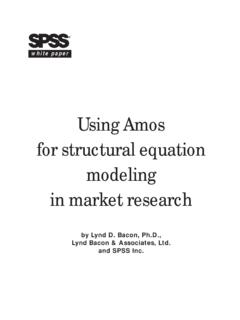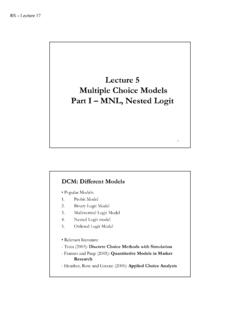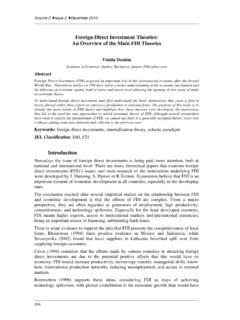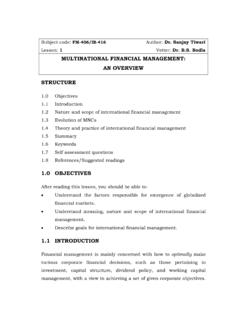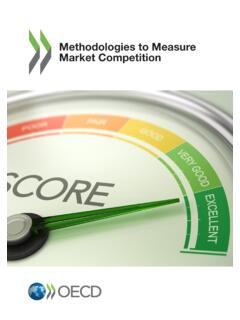Transcription of CHAPTER V FORECASTING EXCHANGE RATES I. Forecasting ...
1 CHAPTER V FORECASTING EXCHANGE RATES One of the goals of studying the behavior of EXCHANGE RATES is to be able to forecast EXCHANGE RATES . Chapters III and IV introduced the main theories used to explain the movement of EXCHANGE RATES . These theories fail to provide a good approximation to the behavior of EXCHANGE RATES . FORECASTING EXCHANGE RATES , therefore, seems to be a difficult task. This CHAPTER analyzes and evaluates the different methods used to forecast EXCHANGE RATES . This CHAPTER closes with a discussion of EXCHANGE rate volatility. I. FORECASTING EXCHANGE RATES International transactions are usually settled in the near future. EXCHANGE rate forecasts are necessary to evaluate the foreign denominated cash flows involved in international transactions. Thus, EXCHANGE rate FORECASTING is very important to evaluate the benefits and risks attached to the international business environment. A forecast represents an expectation about a future value or values of a variable.
2 The expectation is constructed using an information set selected by the forecaster. Based on the information set used by the forecaster, there are two pure approaches to FORECASTING foreign EXCHANGE RATES : (1) The fundamental approach. (2) The technical approach. Fundamental Approach The fundamental approach is based on a wide range of data regarded as fundamental economic variables that determine EXCHANGE RATES . These fundamental economic variables are taken from economic models. Usually included variables are GNP, consumption, trade balance, inflation RATES , interest RATES , unemployment, productivity indexes, etc. In general, the fundamental forecast is based on structural (equilibrium) models. These structural models are then modified to take into account statistical characteristics of the data and the experience of the forecasters. It is a mixture of art and science. (See Appendix IV.)
3 Practitioners use structural model to generate equilibrium EXCHANGE RATES . The equilibrium EXCHANGE RATES can be used for projections or to generate trading signals. A trading signal can be generated every time there is a significant difference between the model-based expected or forecasted EXCHANGE rate and the EXCHANGE rate observed in the market. If there is a significant difference between the expected foreign EXCHANGE rate and the actual rate, the practitioner should decide if the difference is due to a mispricing or a heightened risk premium. If the practitioner decides the difference is due to mispricing, then a buy or sell signal is generated. Fundamental Approach: FORECASTING at Work The fundamental approach starts with a model, which produces a FORECASTING equation. This model can be based on theory, say PPP, a combination of theories or on the ad-hoc experience of a practitioner.
4 Based on this first step, a forecaster collects data to estimate the FORECASTING equation. The estimated FORECASTING equation will be evaluated using different statistics or measures. If the forecaster is happy with the model, she will move to the next step, the generation of forecasts. The final step is the evaluation of the forecast. As mentioned above, a forecast represents an expectation about a future value or values of a variable. In this CHAPTER , we will forecast a future value of the EXCHANGE rate, St+T. The expectation is constructed using an information set selected by the forecaster. The information set should be available at time t. The notation used for forecasts of St+T is: Et[St+T], where Et[.] represent an expectation taken at time t. Each forecast has an associated FORECASTING error, t+1. We will define the FORECASTING error as: t+1= St+1 - Et[St+1] The FORECASTING error will be used to judge the quality of the forecasts.
5 A typical metric used for this purpose is the Mean Square Error or MSE. The MSE is defined as: MSE = [( t+1)2 + ( t+2)2 + ( t+3)2 + .. + ( t+Q)2]/Q, where Q is the number of forecasts. We will say that the higher the MSE, the less accurate the FORECASTING model. There are two kinds of forecasts: in-sample and out-of-sample. The first type of forecasts works within the sample at hand, while the latter works outside the sample. In-sample FORECASTING does not attempt to forecast the future path of one or several economic variables. In-sample FORECASTING uses today's information to forecast what today's spot RATES should be. That is, we generate a forecast within the sample (in-sample). The fitted values estimated in a regression are in-sample forecasts. The corresponding forecast errors are called residuals or in-sample FORECASTING errors. On the other hand, out-of-sample FORECASTING attempts to use today s information to forecast the future behavior of EXCHANGE RATES .
6 That is, we forecast the path of EXCHANGE RATES outside of our sample. In general, at time t, it is very unlikely that we know the inflation rate for time t+1. That is, in order to generate out-of-sample forecasts, it will be necessary to make some assumptions about the future behavior of the fundamental variables. Summary: Fundamental FORECASTING Steps (1) Selection of Model (for example, PPP model) used to generate the forecasts. (2) Collection of St, Xt (in the case of PPP, EXCHANGE RATES and CPI data needed.) (3) Estimation of model, if needed (regression, other methods) (4) Generation of forecasts based on estimated model. Assumptions about Xt+T may be needed. (5) Evaluation. Forecasts are evaluated. If forecasts are very bad, model must be changed. Example : In-sample FORECASTING EXCHANGE RATES with PPP Suppose you work for a firm. You are given the following quarterly CPI series in the and in the from 2008:1 to 2009:3.
7 The EXCHANGE rate in 2008:1 is equal to USD/GBP. You believe that this EXCHANGE rate, USD/GBP, is an equilibrium rate. Your job is to generate equilibrium EXCHANGE RATES using PPP. In order to do this, you do quarterly in-sample forecasts of the USD/GBP EXCHANGE rate using relative PPP. That is, Et+1[st+1] = sFt+1 = (SFt+1/St) - 1 Id,t+1 - If,t+1 = IUS,t+1 - IUK,t+1. The forecasted level of the EXCHANGE rate USD/GBP for next period is given by Et[St+1]=SFt+1=: Et+1[St+1] = SFt+1 = SFt x [1 + sFt+1]. Date CPI CPI Inflation (IUS) Inflation (IUK) In-Sample Forecast (SFt+1) Actual (St) Forecast Error t+1=SFt+1-St+1 - - - Some calculations for SF2008:2 and SF2008:3: 1.
8 Forecast SF2008:2. IUS,2008:2 = (USCPI2008:2/USCPI2008:1) - 1 = ( ) - 1 = IUK,2008:2 = (UKCPI2008:2/UKCPI2008:1) - 1 = ( ) - 1 = sF2008:2 = IUS,2008:2 - IUK,2008:2 = - = SF2008:2 = SF2008:1 x [1 + sF2008:2] = USD/GBP x [1 + ( )] = USD/GBP. 2008:2 = SF2008:2-S2008:2 = = 2. Forecast SF2008:3. SF2008:3 = S2008:2 x [1 + sF2008:3] = USD/GBP x [1 + ( )] = USD/GBP. 2008:3 = SF2008:3-S2008:3 = = 3. Evaluation of forecasts. MSE: [( )2 + ( )2 + ( )2 + .. + ( )2]/6 = Now, you can generate trading signals. According to this PPP model, the equilibrium EXCHANGE rate in 2008:2 should be USD/GBP. The market price, however, is USD/GBP. That is, the market is valuing the GBP higher than your fundamental model. Suppose you believe that the difference ( ) is due to miss-pricing factors, then you will generate a sell GBP signal. In general, practitioners will divide the sample in two parts: a longer sample (estimation period) and a shorter sample (validation period).
9 The estimation period is used to select the model and to estimate its parameters. Suppose we are interested in one-step-ahead forecasts. The one-step-ahead forecasts made in this period are in-sample forecasts, not true forecasts. These one-step-ahead forecasts are just fitted values. The corresponding forecast errors are called residuals. The data in the validation period are not used during model and parameter estimation. One-step-ahead forecasts made in this period are true forecasts, often called backtests. These true forecasts and their error statistics are representative of errors that will be made in FORECASTING the future. A forecaster will use the results from this validation step to decide if the selected model can be used to generate outside the sample forecasts. Figure shows a typical partition of the sample. Suppose that today is March 2015 and a forecaster wants to generate monthly forecasts until January 2016.
10 The estimation period covers from February 1978 to December 2009. Different models are estimated using this sample. Based on some statistical measures, the best model is selected. The validation period covers from January 2010 to March 2015. This period is used to check the FORECASTING performance of the model. If the forecaster is happy with the performance of the forecasts during the validation period, then the forecaster will use the selected model to generate out-of-sample forecasts. Figure : Estimation, Validation & Out-of-sample Periods. Example : Out-of-sample FORECASTING EXCHANGE RATES with PPP Go back to Example Now, you want to generate out-of-sample forecasts. You need to make some assumptions about the future behavior of the inflation rate. (A) Naive assumption: Et[It+1] = IFt+1 = It. You can generate out-of-sample FORECASTING by assuming that today's inflation is the best predictor for tomorrow's inflation.




